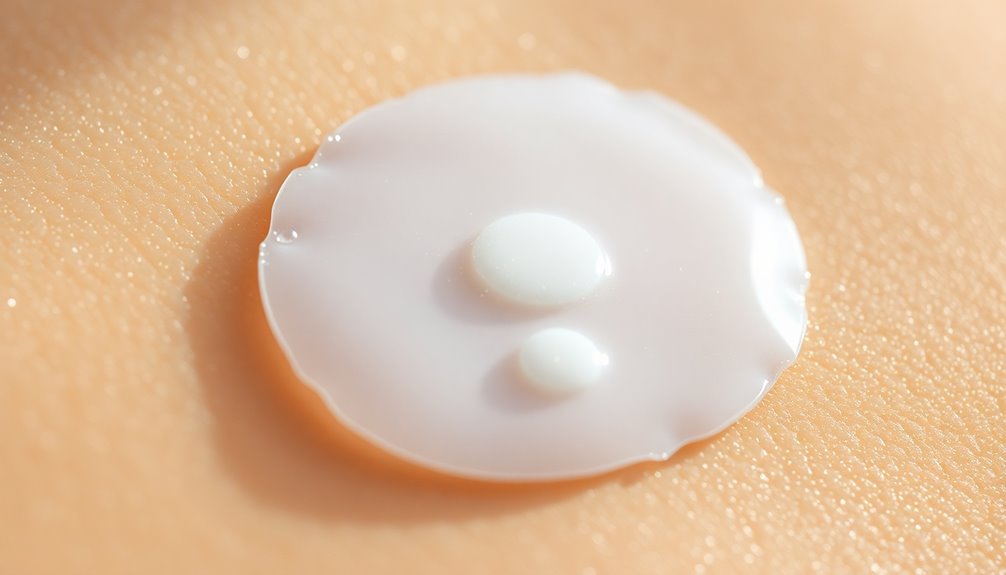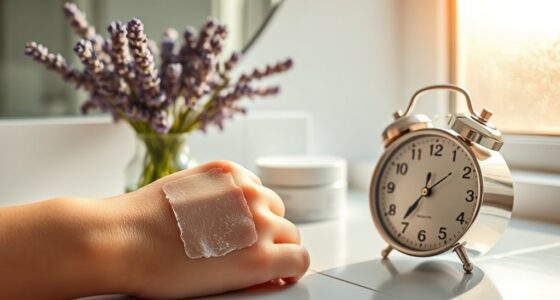Pimple patches turn white as they effectively absorb excess fluids like sebum and pus from your blemish. This color change indicates that the patch is working to promote healing while forming a protective barrier against bacteria. The white appearance shows that impurities have been drawn in, not that the patch is infected. Understanding this process can help calm any worries. You might find it helpful to explore more about how to maximize their effectiveness and alternative options.
Key Takeaways
- Pimple patches turn white due to effective absorption of excess fluids like pus and sebum from blemishes.
- The white color indicates that the hydrocolloid gel is working to promote healing by creating a moist environment.
- This color change is a normal reaction, not a sign of bacteria or infection on the patch.
- The whiteness signifies full absorption, helping users determine when to replace the patch for continued effectiveness.
- Proper application techniques enhance absorption and lead to quicker whitening of the patch, confirming its active function.
Understanding Hydrocolloid Technology
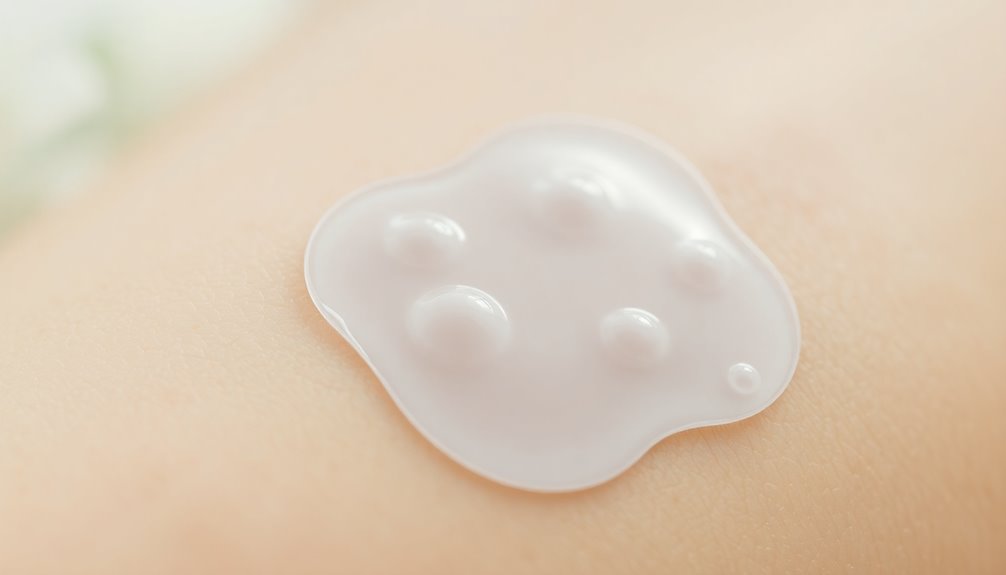
When you apply a hydrocolloid patch to a pimple, you're tapping into an innovative technology that promotes healing.
These patches are designed to absorb excess fluids, such as sebum and pus, which helps to reduce inflammation. As the hydrocolloid patches absorb these impurities, they swell and take on a white appearance, indicating that they're actively working.
This gel-like technology creates a moist environment that's essential for skin recovery, preventing scabs and promoting healing. Additionally, the patches form a protective barrier, keeping bacteria and irritants away from the pimple site. Hydrocolloid technology is often recommended for overnight use for best results.
Originally developed for wound care, hydrocolloid technology effectively draws out impurities while supporting your skin's natural healing process.
The Absorption Process of Pimple Patches
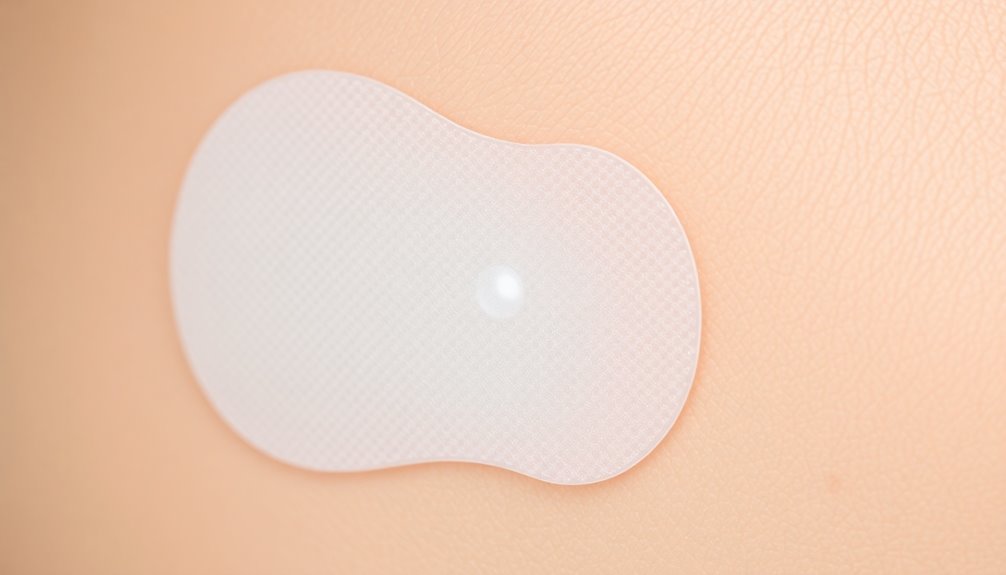
When you apply a pimple patch, the hydrocolloid gel begins to form as it interacts with the pimple's fluid.
You'll notice indicators of absorption as the patch turns white, showing it's pulling out excess oil and impurities.
This transformation not only signals effectiveness but also helps create a moist environment for faster healing. Additionally, the patch provides a protective barrier, which can help prevent antimicrobial properties from external irritants and bacteria.
Hydrocolloid Gel Formation
The absorption process of pimple patches relies on hydrocolloid gel formation, which is essential for their effectiveness.
When you place a patch on a pimple, it interacts with the moisture, triggering the hydrocolloid to swell and absorb excess fluids like sebum and pus. This transformation creates the white appearance you see, indicating the patch is actively drawing out impurities.
As the hydrocolloid absorbs fluids, it not only protects the pimple from external irritants but also creates a moist environment that supports healing.
The white residue you notice is primarily hydrated hydrocolloid, showcasing the patch's ability to manage blemishes effectively. Additionally, maintaining hydration levels is important for overall skin health, which can complement the benefits of using pimple patches.
Fluid Absorption Indicators
Fluid absorption indicators are essential for understanding how well your pimple patch is performing.
As the hydrocolloid material absorbs excess fluids like sebum, pus, and bacteria from your blemish, it turns white. This color change shows that the patch is actively working to draw out impurities, aiding the healing process.
The white residue you see consists of hydrated hydrocolloid gel mixed with the absorbed fluids, signaling that the patch is doing its job.
By monitoring the whiteness of your pimple patches, you can determine when it's time to replace them for continued effectiveness. Additionally, using patches that incorporate natural and organic ingredients can further enhance skin healing while minimizing irritation.
Keeping an eye on these indicators can help enhance your skincare routine and promote faster healing of your skin.
What Does the White Color Indicate?

When your pimple patch turns white, it shows that it's actively absorbing impurities like sebum and pus.
This reaction of the hydrocolloid gel indicates it's doing its job by creating a healing environment for your skin.
Recognizing this change can help you understand when to remove the patch for the best results.
Absorption of Impurities
A pimple patch turning white is a clear sign that it's doing its job. This white stuff on the pimple indicates that the hydrocolloid material has effectively absorbed fluids, including excess sebum and pus, from the blemish.
As the patch absorbs moisture, it swells, showcasing active absorption at work. The transformation to white is a visual cue that the patch is drawing out impurities, promoting the healing process.
It's essential to recognize that this white substance isn't pus or bacteria; rather, it's the hydrated gel of the hydrocolloid. If you notice the patch becoming fully white, it may be time to replace it to continue treating the area effectively. Hydrocolloid patches, like those from Starface Acne Patches, are designed specifically for this effective treatment of blemishes.
Hydrocolloid Gel Reaction
While you might be curious about the white color on your pimple patch, it's actually a positive indication of the hydrocolloid gel at work.
This white spot reveals that the hydrocolloid has absorbed excess fluids, like sebum and pus, from your pimple. As it absorbs these impurities, the gel swells and becomes opaque, signaling active healing.
This transformation helps flatten the pimple, reducing its size and promoting a quicker healing time. Many people mistakenly believe the white substance is pus or bacteria, but it's just hydrated hydrocolloid doing its job. Additionally, using patches with quality ingredients can enhance the healing process and improve overall skin health.
Healing Environment Maintenance
Seeing your pimple patch turn white indicates that it's doing its job well by creating an ideal healing environment.
This color change shows the patch works effectively, absorbing excess fluid from the pimple, including sebum and pus. As the hydrocolloid material absorbs moisture, it swells and becomes gel-like, turning white and opaque.
This transformation signals that the patch creates a moist, healing environment, which helps reduce inflammation and promotes faster recovery.
The white residue you see consists of the impurities extracted, proving that the patch not only acts as a barrier against external irritants but also encourages healing. Topical application of essential oils like tea tree oil can also support the healing process, providing additional antibacterial properties.
If the pimple persists, it may be time to replace the patch, as it has likely completed its function.
Factors Influencing Pimple Patch Effectiveness
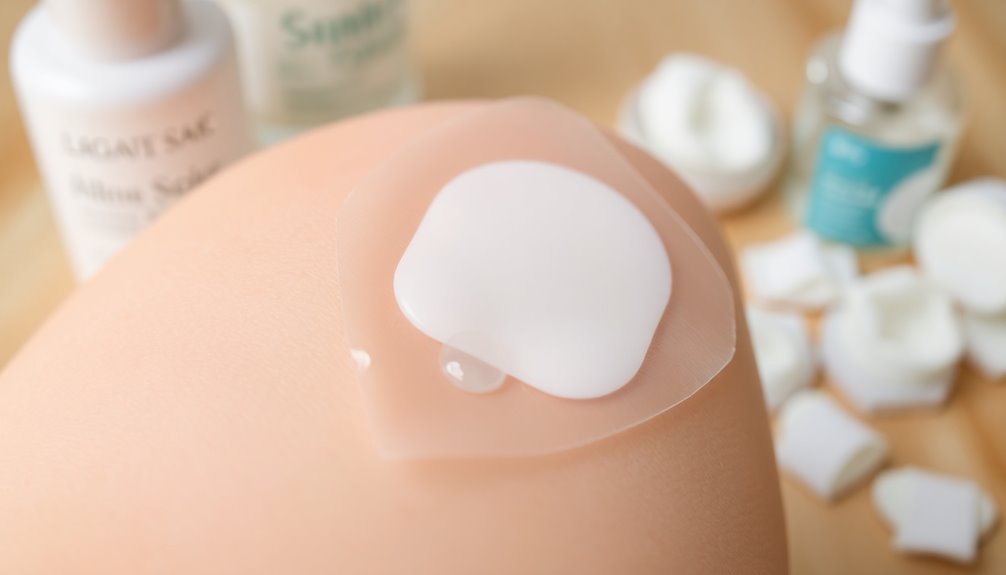
When it comes to the effectiveness of pimple patches, several key factors come into play that can make a noticeable difference in your results.
Here are three important aspects to take into account:
- Type of Blemish: Hydrocolloid patches are best for oozing pimples, not dry or cystic acne.
- Proper Application Technique: Clean and dry your skin before applying the patch to maximize absorption efficiency.
- Duration of Wear: Leave the patch on for 6-8 hours to optimize healing and absorption of impurities from the affected area. Additionally, maintaining a balanced diet can support overall skin health and potentially reduce breakouts.
Best Practices for Using Pimple Patches
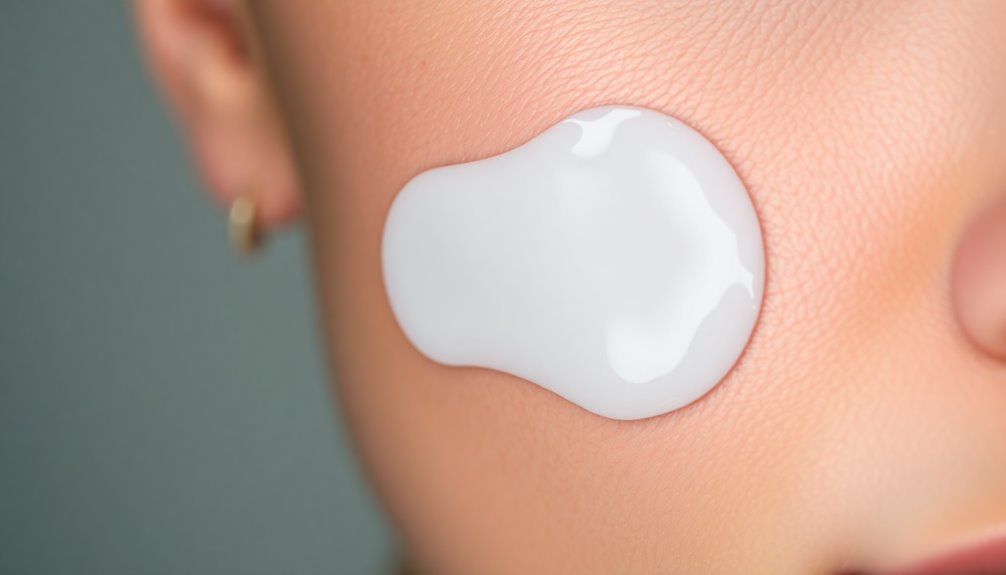
To get the most out of your pimple patches, following best practices is key. Start by cleansing and drying the affected area thoroughly to guarantee maximum adhesion. Choose the right size patch to cover the blemish entirely, allowing the hydrocolloid to absorb impurities effectively. Leave the patch on for at least 6 to 8 hours—overnight is ideal—to facilitate the healing process. Afterward, gently peel it off. If the patch remains white, consider applying a new one for continued treatment. Avoid touching or picking at the pimple while the patch is on, as this helps prevent infection and promotes faster healing of acne vulgaris. Additionally, maintaining a balanced water requirements for your skin can contribute to overall skin health.
| Step | Action | Purpose |
|---|---|---|
| 1 | Cleanse and dry the area | Maximize adhesion |
| 2 | Choose appropriate size | Full coverage |
| 3 | Leave on for 6-8 hours | Absorb impurities |
| 4 | Gently peel off | Monitor healing process |
Common Misconceptions About Pimple Patches
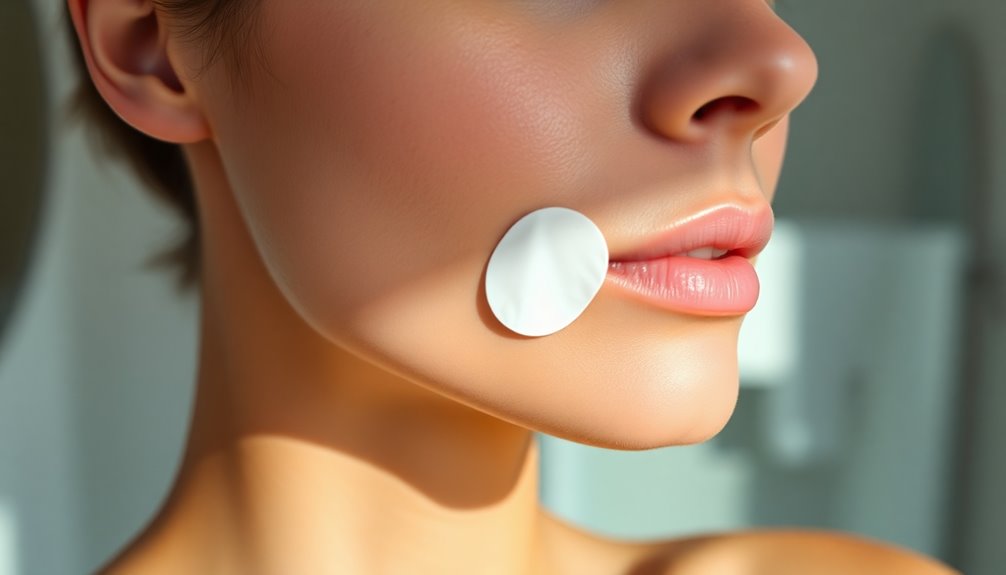
What do you think happens when a pimple patch turns white? Many people have misconceptions about this common occurrence. The truth is that the white substance isn't pus or oil; it's hydrated hydrocolloid absorbing fluid from your acne.
Here are three key points to reflect upon:
- The white appearance indicates that the patch effectively absorbs fluid and moisture from the pimple.
- It's not a sign of bacteria or infection; it's simply the patch interacting with excess sebum and impurities.
- Dermatologists confirm that this reaction is normal for hydrocolloid pimple patches and shows they're working, not failing. Additionally, using patches after all other skincare products can enhance their effectiveness in targeting blemishes.
Understanding these points can help you manage your expectations and improve your skincare routine.
Alternatives to Pimple Patches for Acne Treatment
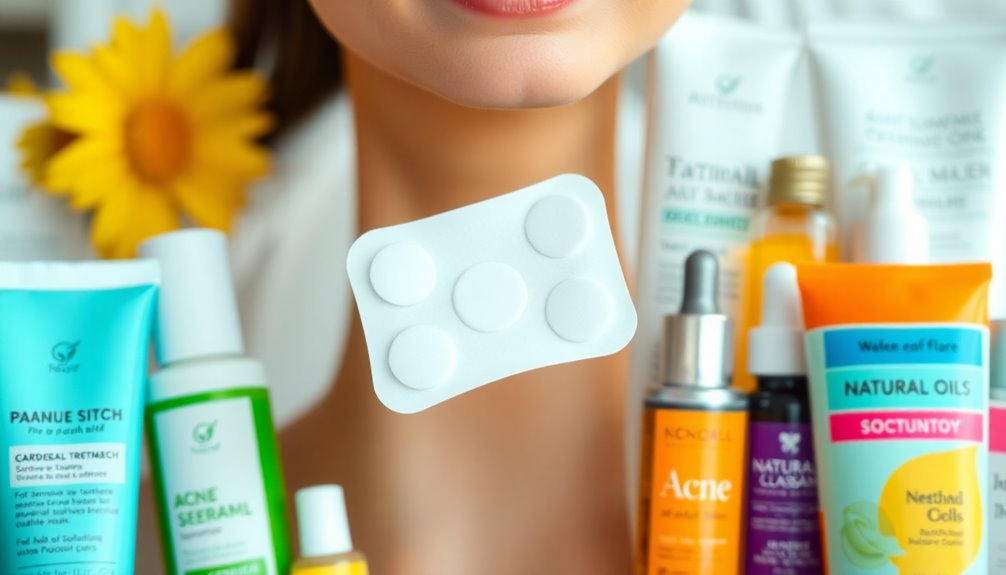
While pimple patches can be effective for many, they aren't the only solution for acne treatment.
You might consider topical treatments containing salicylic acid, which helps unclog pores and reduce inflammation, making it ideal for active breakouts.
Benzoyl peroxide is another powerful option, targeting bacteria and helping to dry out excess oil on your skin.
If you're looking for something gentler, niacinamide can reduce redness and regulate oil production without irritation.
For a natural approach, diluted tea tree oil has antimicrobial properties that can effectively reduce the size and redness of pimples.
In more severe cases, prescription treatments like topical retinoids promote cell turnover, preventing clogged pores and offering a more robust solution than pimple patches.
Frequently Asked Questions
Do Pimple Patches Work on Unpopped Pimples?
Yes, pimple patches do work on unpopped pimples!
When you apply a patch, it creates a moist environment that helps absorb excess oil and impurities.
Even if the pimple hasn't released any fluid yet, the hydrocolloid material can still flatten it over time and reduce inflammation.
Just make sure to leave the patch on for several hours to maximize its effectiveness.
You might be surprised at how well it helps your skin heal!
How Do You Know if a Pimple Patch Is Working?
You can tell if a pimple patch is working by watching for changes in its appearance.
If it turns white, that's a good sign—it means it's absorbing excess fluids from the pimple.
A clear patch after several hours might mean the patch isn't adhering well or there isn't any fluid to absorb.
Do Pimple Patches Get Pus Out?
When it comes to pimple patches, you're in for a treat if you're looking to tackle pesky blemishes!
These patches can indeed draw out pus from certain types of acne. They work by absorbing excess fluid and impurities, helping to shrink the pimple and reduce inflammation.
However, keep in mind that their effectiveness varies, so they mightn't work as well on non-oozing types like blackheads or cystic acne.
Is It Bad to Keep Pimple Patches on for Too Long?
Yes, it can be bad to keep pimple patches on for too long.
Most patches are meant to be worn for about 6 to 8 hours. Leaving them on longer can irritate your skin or trigger an allergic reaction due to the adhesive.
Plus, excessive time can trap moisture and heat, potentially leading to bacteria growth instead of healing.
Always check your skin's response, and if irritation occurs, it's best to remove the patch.
Conclusion
To sum up, when your pimple patch turns white, it's like a tiny sponge soaking up the impurities from your skin. This change signals that it's doing its job, drawing out moisture and debris. To maximize its effectiveness, remember to apply it on clean, dry skin and leave it on for the recommended time. By understanding how these patches work, you can better tackle those pesky breakouts and enjoy clearer skin with confidence!
